

LM Coronavirus Workplace Protections and Available Options for Concerned Employees 2020 709634 7. Michigan Supreme Court's Decision Against COVID-19 Executive Orders Still No Treat for Business. The Michigan Supreme Court, in a divided opinion, recently invalidated Michigan’s Emergency Powers of Governor Act of 1945, MCL 10.31 et seq.
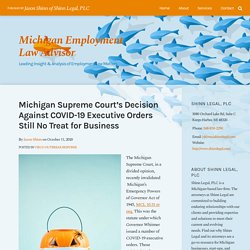
This was the statute under which Governor Whitmer issued a number of COVID-19 executive orders. Those orders, therefore, will now be void by the end of October. The case is Midwest Inst of Health, PLLC v Governor of Michigan (In re Certified Questions from the United States Dist Court), _ Mich __, __ NW2d __ (Oct. 2, 2020). Why it Matters: Michigan Provides Employers and Employees COVID-19 Protections - Ogletree Deakins. Michigan Governor Gretchen Whitmer recently signed into law four bills that encourage employers to resume business in compliance with all COVID-19 safeguards required under the various federal, state, and local statutes, rules, regulations, executive orders, and agency orders.

The new laws provide a significant reward for an employer’s compliance: insulation from COVID-19–related liability—including tort claims and claims under the Michigan Occupational Safety and Health Act of 1974 (MIOSHA)—as long as the employer was implementing all safeguards legally required at the time of the incident giving rise to the claim. This protection extends beyond the employer-employee relationship. However, the protection does not alter any employer liability under the Michigan Workers’ Disability Compensation Act of 1969. The new laws are effective immediately and are made retroactive to March 1, 2020. House Bill Nos. 6031 and 6101: MIOSHA Amendments. Governor Whitmer Signs COVID-19 Legislation Applicable to All Employers.
Risk of infection: Air purifiers remove 90% of aerosols in school classrooms. The most dangerous route to an infection with SARS-CoV-2 is via the air: For example, when infected persons sneeze or cough, they catapult relatively large droplets which, however, sink to the ground within a radius of two meters.
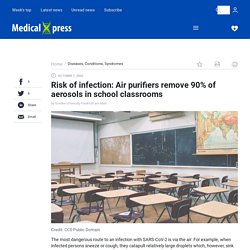
Important are also aerosols, much smaller droplets, which we emit when speaking or breathing. Studies show that infectious SARS-CoV-2 pathogens can still be detected in such aerosols over three hours after emission and several meters away from an infected person. The fluid in such aerosol particles evaporates quickly, making them smaller and able to disperse in a room within a few minutes. Together with his team, Joachim Curtius, professor for experimental atmospheric research at Goethe University, tested four air purifiers in a classroom with 27 students and their teachers over a period of a week. The purifiers had a simple prefilter for coarse dust particles and fluff as well as HEPA and active carbon filters. More information: Joachim Curtius et al. Testing mobile air purifiers in a school classroom: Reducing the airborne transmission risk for SARS-CoV-2. Airborne transmission of Covid-19: A room, a bar and a class: how the coronavirus is spread through the air.
The coronavirus is spread through the air, especially in indoor spaces.
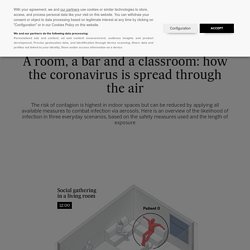
While it is not as infectious as measles, scientists now openly acknowledge the role played by the transmission of aerosols – tiny contagious particles exhaled by an infected person that remain suspended in the air of an indoor environment. How does the transmission work? And, more importantly, how can we stop it? These are respiratory droplets that are less than 100 micrometers in diameter that can remain suspended in the air for hours 1,200 aerosols are released for each droplet These are particles that are larger than 300 micrometers and, due to air currents, fall to the ground in seconds.
CDC expands definition of “close contacts,” after study suggests COVID-19 can be passed in brief interactions. The Centers for Disease Control and Prevention on Wednesday expanded how it defines a “close contact” of someone with Covid-19 as it released new evidence showing the coronavirus can be passed during relatively brief interactions.

Previously, the CDC described a close contact as someone who spent 15 minutes or more within six feet of someone who was infectious. Now, the agency says it’s someone who spent a cumulative 15 minutes or more within six feet of someone who was infectious over 24 hours, even if the time isn’t consecutive, according to an agency spokesperson. Close contacts are those who are tracked down during contact tracing and are recommended to quarantine. advertisement. It’s Time to Talk About Covid-19 and Surfaces Again. COVID-19: DOL Issues Temporary Final Rule on Expanded Paid Sick and Family Leave Entitlements. Employers must recognize that the FFCRA actually contains two emergency paid leave provisions—(1) the Emergency Paid Sick Leave Act (EPSLA), and (2) the Emergency Family and Medical Leave Expansion Act (EFMLEA).
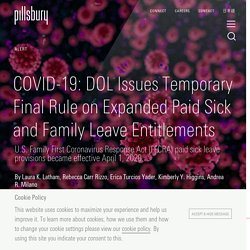
For employers with fewer than 500 employees, compliance with the FFCRA, as well as any state and local paid sick leave provisions, remains critical to avoid possible employee claims and litigation. Usage Rules Confirm Prior FAQ Responses The new regulations confirm that an employee is not entitled to take EPSL if there is no work available to the employee. To be entitled to EPSL, the employee must not be able to work (or telework) because the employee is impacted by one of the six covered reasons (explained in more detail in Pillsbury’s March 18, 2020 client alert). Small Business Exemption is Not Automatic, and Limited in Applicability Many employers with fewer than 50 employees have misplaced comfort that the FFCRA is not applicable to them. FAQs: The Families First Coronavirus Response Act for Employers. On March 18, 2020, Congress passed, and President Trump signed, the Families First Coronavirus Response Act (“FFCRA”).
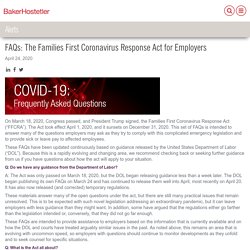
The Act took effect April 1, 2020, and it sunsets on December 31, 2020. This set of FAQs is intended to answer many of the questions employers may ask as they try to comply with this complicated emergency legislation and to provide sick or leave pay to affected employees. These FAQs have been updated continuously based on guidance released by the United States Department of Labor (“DOL”). Because this is a rapidly evolving and changing area, we recommend checking back or seeking further guidance from us if you have questions about how the act will apply to your situation. Q: Do we have any guidance from the Department of Labor? Coronavirus (COVID-19), Stress, and Mental Health Conditions. During these unprecedented times there is a lot of confusion and uncertainty about the coronavirus.
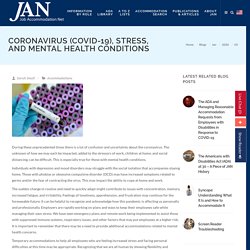
The unknown of how we may each be impacted, added to the stressors of work, children at home, and social distancing, can be difficult. This is especially true for those with mental health conditions. Individuals with depression and mood disorders may struggle with the social isolation that accompanies staying home. Those with phobias or obsessive compulsive disorder (OCD) may have increased symptoms related to germs and/or the fear of contracting the virus. This may impact the ability to cope at home and work. The sudden change in routine and need to quickly adapt might contribute to issues with concentration, memory, increased fatigue, and irritability.
Temporary accommodations to help all employees who are feeling increased stress and facing personal difficulties at this time may be appropriate. Coronavirus Disease 2019 (COVID-19) Introduction Employers covered by the ADA should keep the following strategies in mind when dealing with communicable diseases such as COVID-19 in the workplace.

The first is to make decisions based on facts, what is actually happening, and not speculation. Under the ADA, employers can make decisions based on safety concerns, but they have to be real. So, employers should determine what’s really going on. Furthermore, employers should remember the ADA medical exam and inquiry rules apply when they are assessing workplace situations. COVID-19 and the Fair Labor Standards Act Questions and Answers. Please see Families First Coronavirus Response Act: Questions and Answers for questions specific to the application of the Families First Coronavirus Response Act and paid leave.

If your business has a shortage of workers and is looking to “volunteers” to help out, be aware that the Fair Labor Standards Act (FLSA) has stringent requirements with respect to the use of volunteers. COVID-19 and the American Workplace. Temporary Rule: Paid Leave under the Families First Coronavirus Response Act On April 1, 2020, the U.S. Department of Labor announced new action regarding how American workers and employers will benefit from the protections and relief offered by the Emergency Paid Sick Leave Act and Emergency Family and Medical Leave Expansion Act, both part of the Families First Coronavirus Response Act (FFCRA). The Department’s Wage and Hour Division (WHD) posted a temporary rule issuing regulations pursuant to this new law, effective April 1, 2020. For more information, see (en español: Licencia Laboral Pagada bajo Ley Familias Primero de Respuesta al Coronavirus). FFCRA will help the United States combat and defeat COVID-19 by reimbursing American private employers that have fewer than 500 employees with tax credits for the cost of providing employees with paid leave taken for specified reasons related to COVID-19.
Online Tool: Determine Your FFCRA Eligibility Fact Sheets. - The Washington Post. Families First Coronavirus Response Act: Employee Paid Leave Rights.